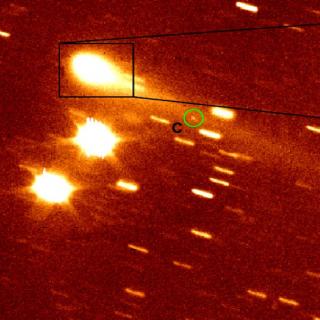Bibcode
Moreno, F.; Cabrera-Lavers, A.; Vaduvescu, O.; Licandro, J.; Pozuelos, F.
Bibliographical reference
The Astrophysical Journal Letters, Volume 770, Issue 2, article id. L30, 6 pp. (2013).
Advertised on:
6
2013
Citations
26
Refereed citations
25
Description
The Main-Belt Comet P/2012 T1 (PANSTARRS) has been imaged using the 10.4
m Gran Telescopio Canarias and the 4.2 m William Herschel Telescope at
six epochs in the period from 2012 November to 2013 February, with the
aim of monitoring its dust environment. The dust tails' brightness and
morphology are best interpreted in terms of a model of sustained dust
emission spanning four to six months. The total dust mass ejected is
estimated at ~6-25 × 106 kg. We assume a
time-independent power-law size distribution function, with particles in
the micrometer to centimeter size range. Based on the quality of the
fits to the isophote fields, an anisotropic emission pattern is favored
against an isotropic one, in which the particle ejection is concentrated
toward high latitudes (±45° to ±90°) in a
high-obliquity object (I = 80°). This seasonally driven ejection
behavior, along with the modeled particle ejection velocities, are in
remarkable agreement to those we found for P/2010 R2 (La Sagra).
Related projects

Small Bodies of the Solar System
This project studies the physical and compositional properties of the so-called minor bodies of the Solar System, that includes asteroids, icy objects, and comets. Of special interest are the trans-neptunian objects (TNOs), including those considered the most distant objects detected so far (Extreme-TNOs or ETNOs); the comets and the comet-asteroid
Julia de
León Cruz